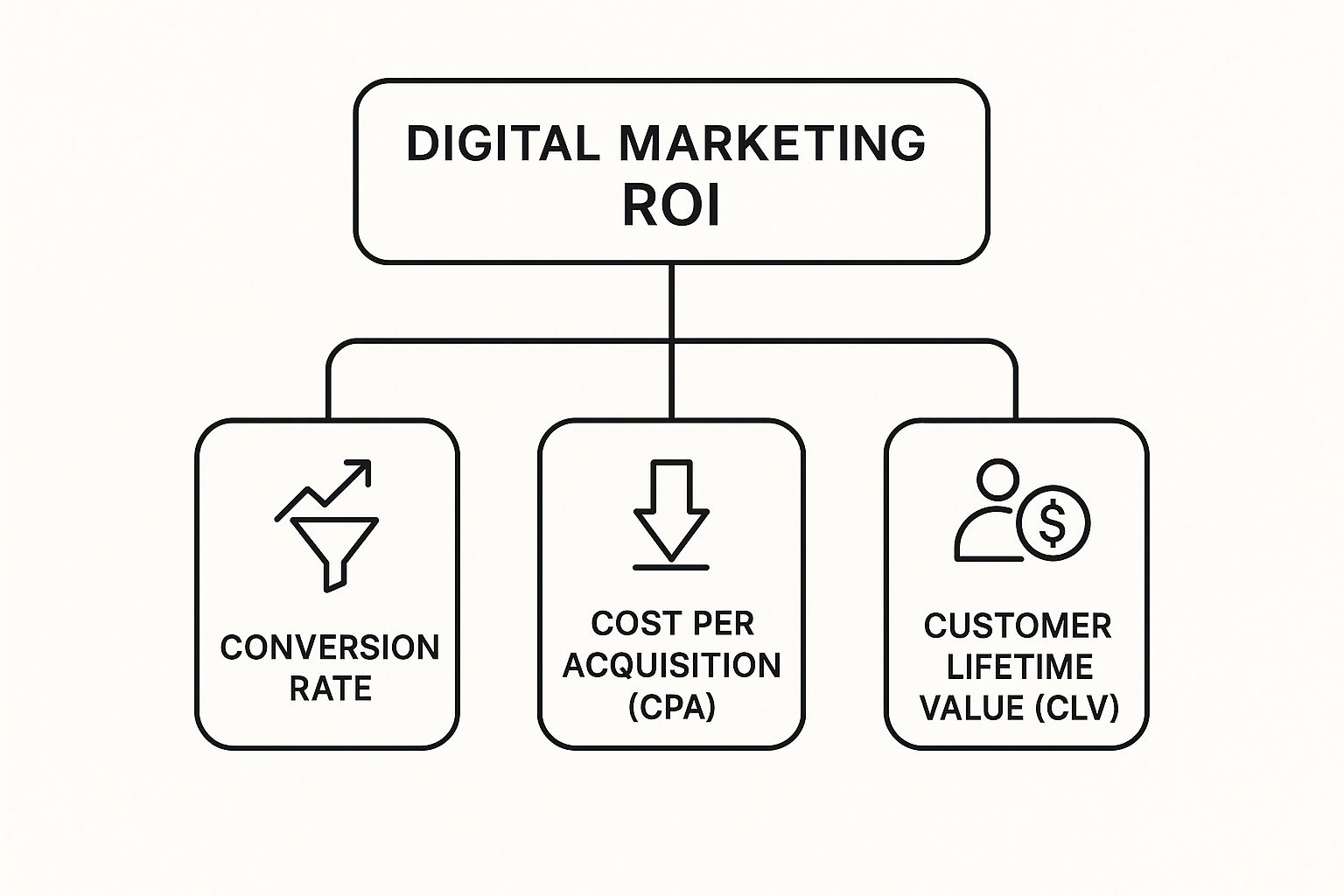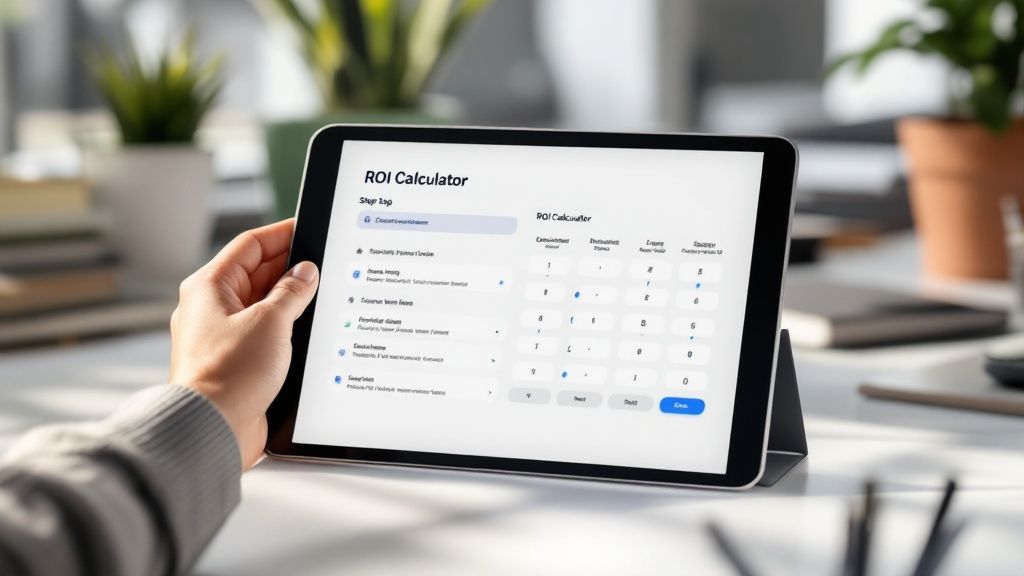
Tired of staring at spreadsheets filled with clicks, likes, and impressions, but struggling to answer the one question that matters: "What's the financial impact?" It's a common pain point for marketers. When the C-suite asks about the bottom line, your data feels fuzzy. This is where a digital marketing ROI calculator becomes your most valuable tool. It translates your hard work into the language of business: profit. This guide will show you how to use one to justify budgets, optimize campaigns, and prove your marketing isn't just a cost center—it's a revenue driver.

What Exactly Is a Digital Marketing ROI Calculator?
Think of a digital marketing ROI calculator less as a complex spreadsheet and more as a financial health check for your campaigns. It’s a tool that helps you look past surface-level metrics like website traffic and get straight to the heart of what matters: profitability. At its core, you plug in your numbers—how much you spent and how much you earned—and it provides a clear picture of your financial performance. To truly understand what the calculator reveals, you need a solid grasp of the various essential marketing performance indicators that paint the full picture of your efforts.
The Basic Formula in Action
The standard ROI formula is beautifully simple: (Net Profit / Total Investment) x 100 = ROI %.
Let's apply this to a real-world scenario. Imagine a content creator invests $1,000 in a social media campaign to promote their new online course. The campaign generates $5,000 in sales.
- Net Profit: $5,000 (Revenue) - $1,000 (Investment) = $4,000
- Calculation: ($4,000 / $1,000) x 100 = 400%
The result is a massive 400% return on investment. This simple calculation moves you from a vague idea of "success" to a concrete number that proves what's truly working.
Gathering the Right Data for an Accurate ROI Calculation
A digital marketing ROI calculator is a powerful tool, but it's not a magic eight ball. The quality of your output is entirely dependent on the quality of your input. Think of it like baking a cake—if you use salt instead of sugar, the result will be disappointing, no matter how great the recipe is. To get an accurate picture of your financial performance, you have to look beyond the obvious numbers and account for every variable.

What to Include in Your Total Investment
First, be meticulous about tracking your costs. This means every single dollar. We're talking about more than just your direct ad spend on Google or Facebook. For a true ROI calculation, you must include:
- Software subscriptions: Your CRM, email marketing platform, and analytics tools.
- Content creation costs: Fees for hiring writers, designers, or videographers.
- Agency or freelance retainers: Any third-party help you hire.
- Team salaries: A portion of the salaries for the team members who worked on the campaign.
Even a well-defined content marketing strategy comes with hidden costs that are easy to forget but essential to include for an accurate calculation.
What to Include in Your Return
Now for the fun part: the returns. But again, we need to go deeper than just top-line revenue from a specific campaign. A truly insightful ROI calculation considers metrics like Customer Lifetime Value (CLV), which shows the total revenue a single customer will generate over their entire relationship with your brand. Understanding the real cost to bring in a new customer is a core part of this equation. A detailed customer acquisition cost calculator guide can be incredibly helpful for nailing down these numbers. When you do this, your final ROI figure isn't just a guess—it's accurate and defensible.
What Does a "Good" Digital Marketing ROI Look Like?
So, your digital marketing ROI calculator spits out a number. Great. But what does that number actually mean? Is it good, bad, or just okay? Without context, it's just a digit on a screen. Think of it as a report card for your marketing efforts; different grades tell you where you’re succeeding and where you need to improve. A widely accepted industry benchmark to shoot for is a 5:1 ratio (or 400% ROI). This means for every dollar you invest, you get five dollars back in revenue.

Here's a simple breakdown of what different ratios mean:
- Below 5:1: Your campaign is profitable, but there's room for optimization.
- 5:1: This is a solid, healthy return and a great goal for most businesses.
- 10:1 or higher: You've found a highly effective strategy. It's time to scale what's working.
However, performance can vary wildly depending on the channel. Email marketing, for example, boasts an average ROI of 36:1, while SEO follows at 22:1. Knowing these benchmarks helps you set realistic goals. In fact, marketers who consistently track ROI are 1.6 times more likely to receive higher budget approvals. To see how different channels stack up, you can explore more digital marketing ROI statistics.
👉 Try MediaWorkbench.ai for free – schedule your posts and generate AI content in one place!
Common Mistakes to Avoid When Calculating ROI
It’s easy to think that calculating ROI is just plugging numbers into a simple formula, but a few common mistakes can render your results meaningless. A good digital marketing ROI calculator is only as smart as the data you give it, so avoiding these pitfalls is crucial for reporting you can actually trust.

One of the biggest blunders is forgetting the "hidden" costs. It's easy to track ad spend, but what about the software subscriptions, creative agency fees, or even the salary hours your team poured into the campaign? These expenses add up and must be included.
Another frequent error is improper attribution. The customer journey is rarely a straight line; it often involves multiple channels and touchpoints. Giving all the credit to the final click without considering the entire path can completely warp your understanding of what's working.
Finally, don't get trapped by short-term thinking. Focusing only on immediate revenue while ignoring long-term metrics like Customer Lifetime Value (CLV) provides a very narrow view of a campaign's true impact. Getting these details right is what separates amateurs from pros. If you need a refresher, explore the fundamentals of digital marketing ROI to build your calculations on a solid foundation.
From Measurement to Mastery
You’ve learned the fundamentals of a digital marketing ROI calculator and how to use it for strategic growth. The key takeaways are clear: track every single cost for accuracy, use the 5:1 ratio as a solid benchmark for success, and most importantly, use your calculations not just to report past performance but to diagnose problems and guide future strategy. Once you master ROI, you can walk into any meeting and confidently prove your value, turning marketing from a cost center into a predictable profit engine.
Now it’s your turn to put these ideas into action. For creators and agencies looking to optimize their workflow, understanding marketing automation best practices is a great next step. A platform like MediaWorkbench.ai is designed to connect your content creation, data analysis, and high-ROI strategies in one place, tying all your hard work directly to measurable results.
Ready to take control of your content workflow and fuel a high-ROI strategy? Try MediaWorkbench.ai and see how our tools can help you create, analyze, and optimize your marketing content in one place. Explore our features today.

